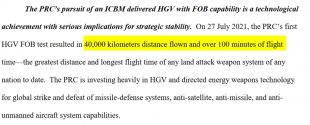25K km not 40K km
You're confusing miles with kilometers.
40,000 km ≈ 25,000 miles ≈ length of the equator (the purpose of this number is simply to suggest it is global range rather than suggest the vehicle flew straight and the distance of the equator).

I should add at this point that this is not a FOBs like thing. That's the politics. FOBS has weapons connotations and is embedded in the thinking of the technology from the Cold War... even though FOBS was technologically unfeasible in the same scope as today's "FOBS". By both US and Chinese accounts, this "FOBS" flew within the atmosphere (so it's really not exactly the Cold War type of conception) and also launched something which the US calls a technology that can be used to deliver nukes (or conventional weapons) and Chinese side hinting that it is an "aircraft" that's capable of deploying aka launching a defensive interceptor. Basically the hint seems to suggest the hypersonic vehicle is capable of firing an interceptor for the purpose of defending the vehicle itself but of course the purpose side is mired in speculation and any launching of objects from a hypersonic vehicle could potentially be tasked with delivering nukes. Both US and China are probably far further ahead in hypersonic and DEW tech then they let on in public.
Last edited:
